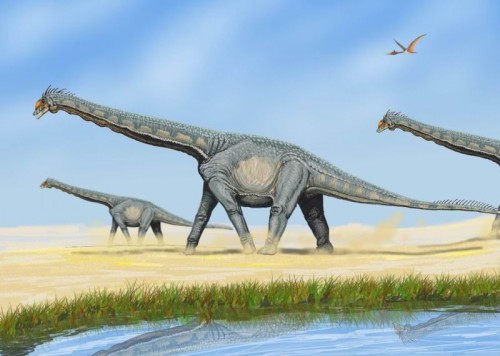Did Dinosaurs Become Extinct 65.5 Million Years Ago?
Geology published a study according to which a dinosaur bone from 64.8 million years ago has been discovered by scientists. The femur bone belonged to Alamosaurus sanjuanensis, a 20 meter long herbivore.
The age of the bone was established utilizing uranium-lead dating that was “based on the decay of two different U-isotopes, 238U and 235U” according to Dr. Heaman from Alberta University in Canada.
Heaman went on: “What is new about our approach to dating dinosaur bone is that we use relatively new technology.”
“This new technology is called laser ablation inductively coupled plasma mass spectrometry. We prepare a thin slice of the bone and then aim a 160-micron-diameter laser beam at selected parts. The laser pulses liberate tiny particles from the bone. These particles are transported to a plasma where they are dissociated and ionized. The ionized particles are accelerated into a mass spectrometer and the isotopic composition of lead is determined.”
Dr. Heaman also stated that “This technique allows the fossil to be dated directly, as apatite, which is a major component of bone mineral, can incorporate uranium. This makes the dating more accurate than other methods that determine the age of fossils from substances in the surrounding area.”
He went on: “The new technique we developed is more accurate than previous unsuccessful attempts at direct dating of bone because the geochemistry of bone can be complex and disturbed by interaction with fluids subsequent to fossilization.”
“Our technique allows us to identify pristine parts of bone that are not disturbed. These well-preserved domains are typically very small, so the ability to specifically access the material in these undisturbed domains has been key to the success of the technique.”
According to a press release emitted by Alberta University, the discovery of the sauropod fossil bone “confounds the long-established paradigm that the age of dinosaurs ended between 65.5 and 66 million years ago.”
Non-avian dinosaurs were formerly believed to have become extinct when the Cretaceous-Tertiary extinctions took place; that is about 700,000 years before the period to which the bone is supposed to belong.
Heaman explains: “The fossil-bearing layer that contains the young bone we dated is located above the K/T [Cretaceous-Tertiary] boundary, a boundary identified in many places worldwide that has an anomalous content of iridium, an element that is abundant in meteorites. This has led to the theory that a giant meteorite event occurred at this time and is the single reason why so many species went extinct.”
“There is some debate about the age of this boundary, but the most recent Geologic Time Scale places this boundary at 65.5 Ma [million years ago]. More recent studies have proposed the boundary is even older (66.0 Ma)” Heaman continued.
“At face value, if dinosaurs were all killed off by this event, then there should be no bones preserved in layers above the K/T boundary. Scientists have proposed that, in cases like the layer we studied, dinosaur bones located above the K/T boundary were not originally deposited there; they are older, and through erosion and re-deposition have been move to this site at a later time post-K/T event.
“The age that we obtained for the dinosaur bone is in fact younger than the K/T boundary, so this is the first direct evidence that some dinosaurs survived this event. It opens the question as to what actually caused the dinosaurs to go extinct and could destroy a 30-year-old paradigm that all dinosaurs were killed by a giant meteorite impact at 65.5 Ma.”



